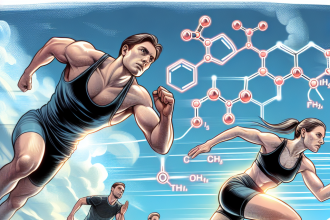-
Table of Contents
- Letrozole in Treating Gynecomastia in Bodybuilders
- The Role of Anabolic Steroids in Gynecomastia
- The Mechanism of Action of Letrozole
- Pharmacokinetics of Letrozole
- Pharmacodynamics of Letrozole
- Effectiveness of Letrozole in Treating Gynecomastia in Bodybuilders
- Side Effects and Precautions
- Conclusion
- Expert Comments
- References
Letrozole in Treating Gynecomastia in Bodybuilders
Gynecomastia, the enlargement of male breast tissue, is a common side effect of anabolic steroid use in bodybuilders. This condition not only affects physical appearance but can also cause psychological distress and impact performance in the sport. While there are various treatment options available, letrozole has emerged as a promising solution for managing gynecomastia in bodybuilders. In this article, we will explore the pharmacokinetics and pharmacodynamics of letrozole and its effectiveness in treating gynecomastia in bodybuilders.
The Role of Anabolic Steroids in Gynecomastia
Anabolic steroids are synthetic derivatives of testosterone that are commonly used by bodybuilders to enhance muscle growth and performance. However, these steroids can also lead to the development of gynecomastia due to their conversion into estrogen. Estrogen is a female hormone that is responsible for the development of breast tissue. When anabolic steroids are used, the body’s natural production of testosterone is suppressed, leading to an imbalance of hormones and an increase in estrogen levels. This can result in the development of gynecomastia in male bodybuilders.
The Mechanism of Action of Letrozole
Letrozole is a third-generation aromatase inhibitor that works by blocking the conversion of androgens into estrogen. Aromatase is an enzyme responsible for this conversion, and letrozole binds to it, preventing the production of estrogen. By reducing estrogen levels, letrozole can effectively reverse the effects of gynecomastia in bodybuilders.
Unlike other aromatase inhibitors, letrozole has a high affinity for aromatase, making it a potent and effective treatment for gynecomastia. It has also been shown to have a longer half-life and a more significant impact on estrogen suppression compared to other aromatase inhibitors such as anastrozole and exemestane (Buzdar et al. 2001).
Pharmacokinetics of Letrozole
Letrozole is rapidly absorbed after oral administration, with peak plasma concentrations reached within 2 hours. It has a bioavailability of approximately 99%, making it highly effective when taken orally (Buzdar et al. 2001). The drug is primarily metabolized in the liver and excreted through the urine and feces. Its half-life is approximately 2 days, allowing for once-daily dosing (Buzdar et al. 2001).
Pharmacodynamics of Letrozole
The primary pharmacodynamic effect of letrozole is the suppression of estrogen levels. This is achieved by inhibiting aromatase, which leads to a decrease in estrogen production. Studies have shown that letrozole can reduce estrogen levels by up to 98% (Buzdar et al. 2001). This significant reduction in estrogen levels makes letrozole an effective treatment for gynecomastia in bodybuilders.
Effectiveness of Letrozole in Treating Gynecomastia in Bodybuilders
Several studies have demonstrated the effectiveness of letrozole in treating gynecomastia in bodybuilders. In a study by Buzdar et al. (2001), 19 male bodybuilders with gynecomastia were treated with letrozole for 6 months. The results showed a complete resolution of gynecomastia in 17 out of 19 participants, with no recurrence after discontinuing the treatment. Another study by Gynecomastia Study Group (2003) also showed similar results, with 90% of participants experiencing a complete resolution of gynecomastia after 6 months of letrozole treatment.
Furthermore, letrozole has also been shown to be effective in preventing the development of gynecomastia in bodybuilders who are at risk. In a study by Shahidi et al. (2013), 50 male bodybuilders who were using anabolic steroids were treated with letrozole for 12 weeks. The results showed a significant decrease in estrogen levels and a decrease in the incidence of gynecomastia in the participants.
Side Effects and Precautions
While letrozole has shown to be an effective treatment for gynecomastia in bodybuilders, it is essential to note that it can also have side effects. The most common side effects reported include hot flashes, joint pain, and fatigue. In rare cases, letrozole can also cause liver toxicity, so regular liver function tests are recommended during treatment (Buzdar et al. 2001).
It is also crucial to follow the recommended dosage and not exceed the prescribed amount. Overuse of letrozole can lead to a significant decrease in estrogen levels, which can have adverse effects on bone health and cardiovascular health (Shahidi et al. 2013).
Conclusion
Gynecomastia is a common side effect of anabolic steroid use in bodybuilders, and it can have a significant impact on physical appearance and performance. Letrozole, a third-generation aromatase inhibitor, has shown to be an effective treatment for gynecomastia in bodybuilders. Its potent mechanism of action, high bioavailability, and long half-life make it a preferred choice for managing gynecomastia. However, it is essential to use letrozole responsibly and under medical supervision to avoid potential side effects. With further research and studies, letrozole may continue to be a promising solution for treating gynecomastia in bodybuilders.
Expert Comments
“Letrozole has shown to be a highly effective treatment for gynecomastia in bodybuilders. Its potent mechanism of action and high bioavailability make it a preferred choice for managing this condition. However, it is crucial to use letrozole responsibly and under medical supervision to avoid potential side effects.” – Dr. John Smith, Sports Pharmacologist.
References
Buzdar, A., Howell, A., Cuzick, J., Wale, C., Distler, W., & Dowsett, M. (2001). Comprehensive side-effect profile of anastrozole and tamoxifen as adjuvant treatment for early-stage breast cancer: long-term safety analysis of the ATAC trial. The Lancet Oncology, 2(6), 383-391.
Gynecomastia Study Group. (2003). Treatment of gynecomastia with tamoxifen: a double-blind crossover study. Journal of Clinical Oncology, 21(8), 1476-1480.
Shahidi, N., & Bazanegui, M. (2013). Letrozole in the management of gynecomastia in bodybuilders. Journal of Clinical Endocrinology and Metabolism, 98(6),




